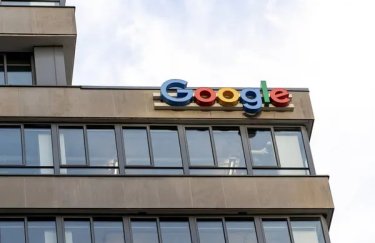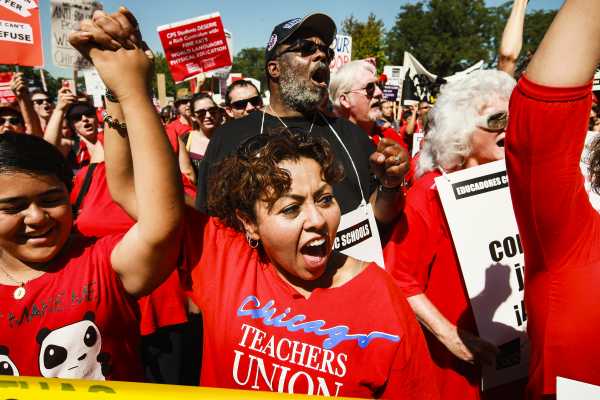 unions back from the dead” alt=”The strike that brought teachers unions back from the dead” />
unions back from the dead” alt=”The strike that brought teachers unions back from the dead” />
The strike that brought teachers unions back from the dead
When these Chicagoans walked off the job in 2012, they changed the future of organizing.
By
Dylan Scott@dylanlscott
Updated
Jul 5, 2019, 9:18am EDT
Share
Tweet
Share
Share
The strike that brought teachers unions back from the dead
tweet
share

On the morning of September 10, 2012, the bells rang to open Chicago’s public schools, but there were no teachers in the classrooms.
The night before, negotiations with Chicago’s reform-minded mayor, Rahm Emanuel, had gone south, and the new activist leaders of the city’s 25,000-member teachers union, clad all in red, walked out. Surrounded by a throng of cameras, they declared that their members would go on strike for the first time in 25 years.
“It looks like a sure bet in hindsight, but at the time, not so much,” recalls Jesse Sharkey, a former high school social studies teacher and chess-team coach who was part of a new guard that took over the Chicago Teachers Union in 2010. “I can remember hearing, ‘They can’t do that!’”
City leaders had been closing schools for years as part of an education reform platform; teachers were becoming easier to fire under new accountability rules. But the strike was a risk they felt they had to take. “We were okay with it,” says Stacy Davis-Gates, who was one of the many black educators to walk out that day (she is now the Chicago union’s vice president). “We had no other choice.”
The teachers needed a new contract, and the two sides were at odds; Emanuel, who’d served as President Barack Obama’s chief of staff and was a year into his job as Chicago’s mayor, wanted to pair raises with layoffs, and the new union leadership wouldn’t accept. They went on strike to demand not only better compensation but also that officials deemphasize standardized tests in determining teacher pay. They wanted smaller class sizes too. They adopted a simple slogan: The Schools Students Deserve.
The strike — the first walkout in a major city since Detroit teachers sought better pay in 2006 — ended nine days later, but not before Emanuel would pursue a court order to try to force teachers back to school. (He failed.) The union won concessions on many of the issues it cared most about: a 16 percent raise over four years, less emphasis on test scores in evaluating teachers, the right for laid-off teachers to get first dibs on new job openings at other schools. Union leaders planned town halls in other cities across the country, in New York and Cleveland, San Francisco and Tampa, to spread the new gospel.
A year later and 2,000 miles away, the new leaders of the Los Angeles teachers union teamed up with parents to oppose the expansion of charter schools and the rest of the city’s education reform agenda. They had a catchy message: The Schools LA Students Deserve.
“It wasn’t yet obvious to the untrained eye what was about to happen in LA,” says Sharkey, now the Chicago union president. “But we knew it.”
This January, the Los Angeles teachers union, under the same leadership that had brought the Chicago method to the West Coast, walked out for six days. It was the first strike in the city in three decades.
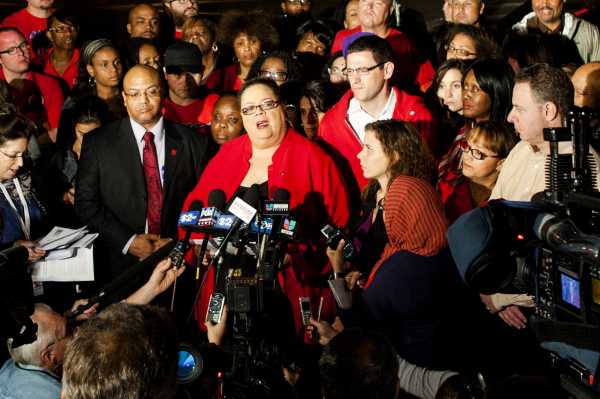
The movement and the message have spread over the past six years. West Virginia teachers, furious about pay cuts and rising health care costs, stopped working in 2018 for 12 days and again this February for two more. While they figured out how they would protest their state’s education spending cuts, they started a virtual book club and read everything they could about the Windy City strike.
Strikes are technically illegal in their right-to-work state, but they walked out anyway. They promised to deliver “the schools West Virginia deserves.”
In Arizona, the scene of another strike, a veteran of the 2012 walkout helped the state’s teachers organize. Teachers in Oklahoma, Oakland, Denver, Kentucky, and elsewhere have gone on strike in the past year.
All owed a debt to Chicago.
“That strike, I don’t think you can overestimate the importance of that,” says Jon Shelton, a University of Wisconsin professor who recently wrote a book on the history of US teachers strikes. “What that showed teachers in other places was unions could put things on the table that hadn’t been on the table before.”
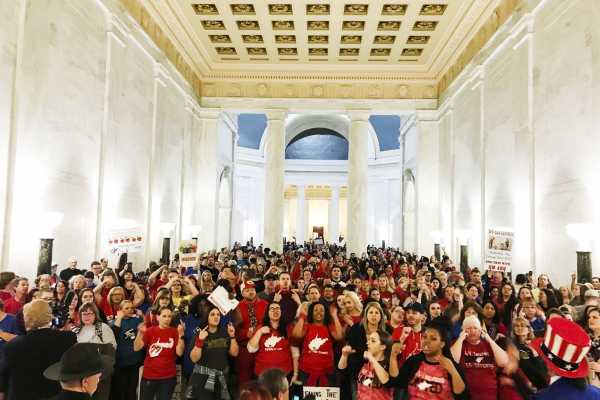
The resurgence of America’s teachers unions is several stories wrapped into one. It is the story of urban backlash to the centrist education reforms that prioritized using test scores to evaluate teachers and empowered charter schools, drawing students and resources away from the traditional neighborhood public school. It is the story of austerity, as many states cut education budgets over the past decade and with them teacher pay and benefits.
It is also a parable of millennial economic angst. The latest generation of teachers entered their classrooms with student debt, mediocre health care, and diminished job prospects. They found themselves open to aggressive political activism.
But it is most fundamentally the story of the renewed American labor protest movement. Inspired by the teachers unions, the #MeToo movement, and the lingering memory of Occupy Wall Street, workers in other industries, including McDonald’s and Stop and Shop employees, have walked out on the job this year to demand better compensation and working conditions.
The Chicago teachers in 2012 showed their compatriots what was possible with solidarity and a compelling message. The strikes that have followed in West Virginia, Oklahoma, and Arizona have proved that the tactics could work as well in rural Republican states as in Democratic cities.
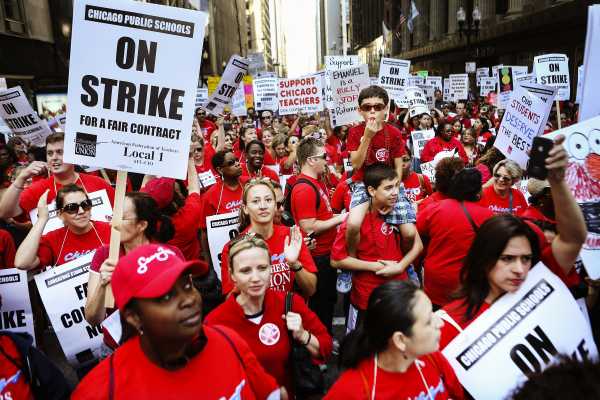
Ground zero for renewed activism
In the 1990s and 2000s, teachers wandered in the political wilderness, boxed in by the reform agenda favored by both their former allies, the Democrats, and business-minded Republicans. The unions’ style of organizing had changed (too much, in their critics’ eyes). In the 1970s, unions emphasized social justice — racial, economic — but quickly had become more conservative, focused on professionalizing the teaching profession.
Agitation within their ranks, like the insurgent teacher caucus led by Karen Lewis and Sharkey that won control of Chicago’s union two years before the 2012 strike, helped push the unions toward more aggressive actions.
“Someone has got to figure out labor is a vehicle for widespread social movement,” says Davis-Gates, the current vice president. For years, she says, union leadership “did not see their power to push back.”
Chicago was a natural place for renewed teacher activism. The very first American Federation of Teachers affiliate, Local 1, organized there in 1897. Jackie Vaughn, its famed leader from 1984 to 1994 and a longtime labor activist, led a four-week strike in 1987, one of the longest in American history.
It was also the incubator for many education reform policies that rankled teachers. Just after Vaughn had stepped down, Mayor Richard Daley took control of the city’s schools in 1995, empowered by a new state law that allowed him to pick every member of the school board. In 2001, Daley appointed as superintendent Arne Duncan, who later became Obama’s education secretary and pushed a reform agenda in Washington. But first, in Chicago, Duncan experimented with a wide range of ideas, including charter schools and stricter teacher accountability based on test data.
It was a tumultuous period. Schools closed, teachers were laid off, and the union felt the strain. There was a brief leadership change in the union in the first half of the 2000s, but the dominant longtime leadership coalition quickly won back power. Soon, a small but growing contingent of teacher activists, led by Lewis and Sharkey, among others, planned a 2010 campaign for election. It brought a racial justice message to the mostly black workforce teaching mostly black students. The two sides ended up in court, as the existing leadership sought to block the activist opposition from campaigning on school grounds.
It was a close election. But after two rounds of voting, the outsiders — who’d dubbed themselves the Caucus of Rank-and-File Educators, or CORE — beat the entrenched leadership.
Afterward, Sharkey remembers, Lewis, their new leader, told him: “You realize if this doesn’t work, we’re one-termers.”
But they pressed on. (Lewis has been diagnosed with brain cancer and was not able to respond to a request for comment.)
“What the fuck is the point of playing it safe so you can oversee a weakening union,” Sharkey says now, “not representing anybody or doing anything?”
The rise and fall of teachers unions
Social justice has long been woven into the fabric of teachers unions. Before Chicago educators formed the Local 1 in 1897, an early education reformer — described by Dana Goldstein in The Teacher Wars as an administrative progressive who had forged an alliance with business leaders — told women teachers they should feel lucky they earned as much as his wife’s maid. He wanted to hire more male teachers.
The new union, modeled on “militant” blue-collar labor organizations, instead won better pay for female teachers; its first president was critical to the suffrage movement in Illinois.
Teachers unions nationwide became active in the 1960s and ’70s, as members got caught up in the momentum of the civil rights movement. They were, in a way, trying to prolong it. New York teachers went on strike for two weeks in 1962. Florida had a statewide walkout in 1968. Chicago teachers went on strike twice, once in 1969 and again in 1971, gaining nation-leading pay increases. In all, there were more than 1,000 teacher strikes between 1960 and 1974.
But the labor movement ran up against powerful forces in the ensuing years. Besides standardized tests and charter schools, teachers faced threats from Republicans who pushed right-to-work laws, and millionaires who favored some of the same ideas Democrats were pursuing and were eager to get into the schools business. An alliance, unlikely in our more polarized times, formed.
“The Democratic Party shifted toward education reform,” Shelton explains. “They adopted the ideology of people giving them money. There was a proliferation of market-based solutions.”
It culminated with No Child Left Behind in 2001. Republican President George W. Bush signed the law, but it was also very much the pet project of Sen. Ted Kennedy, the liberal lion. Democrats voted overwhelmingly for it. Schools would eventually be expected to achieve 100 percent student passage of standardized tests or face financial penalties.
The national unions’ input was largely ignored by lawmakers writing the legislation. As Education Week reported in 2002, the national organizations — the AFT and the National Education Association — were left with “only a handful of wins and many more losses” as they offered “polite press statements” and otherwise felt “lukewarm” toward the law.
The law, with its absolutist standards for schools, was a bust, and its harsher provisions were often waived under Obama. But Democratic leaders were still committed to the reform agenda. The Education Department under Duncan focused on Race to the Top, $1 billion in grants that rewarded states for charter schools and linking teacher evaluations to teacher pay, and the Common Core test standards.
Though many union leaders and members were Democrats, the relationship between the unions and the Democratic establishment reached a nadir in 2014, when the NEA called for Duncan to resign. The AFT nearly did the same. That was two years after Chicago. The times were changing.
“As a result of what happened in Chicago, this successful strike, you started seeing social justice at the forefront and people contesting older white leadership,” says Jennifer Berkshire, a freelance journalist who used to be a member of the AFT.
The labor movement finds its calling again
The teachers movement is still divided on how much blame the union establishment deserves for the waning influence of unions in the 2000s and how much credit the militant, worker-oriented left deserves for reviving the cause. But in Chicago, Los Angeles, and the sites of other recent strikes, it has often been organizing outside of the traditional union structure or a new leadership that has paved the path to more labor actions.
“It’s about changing leadership. Rank-and-file pushing has been important,” says Shelton, the historian. “This happened with grassroots people, who starting by working outside the union.”
There is a debate of either philosophy or tactics here. The more activist teachers believe union leadership became too oriented toward that “professionalization” at the neglect of worker rights and social equity causes. They became hidebound institutions.
“They are intrinsically conservative. They manage a huge business. That’s what it means to have collective bargaining,” says Lois Weiner, a longtime labor activist turned academic from New Jersey who has been a connective tissue for people organizing the recent strikes. “In the wake of 2012, you have the creation of opposition movements in all these places.”
People closer to union leadership say they believe the unions got stuck in a defensive crouch in the reform era, with good reason. They give credit, however, to those who took power in Chicago for pushing the unions to a more confrontational stance in situations where they have the right kind of leverage to win.
“If union leaders had thought they could win a strike under those conditions, they would have been doing it,” Leo Casey, a former New York City union official who now leads the Albert Shanker Institute, a labor think tank inside the AFT, says. He is writing his own book on the recent teachers strikes.
But, he adds, “the danger for a leader in that defensive mode is that they don’t understand that a purely defensive strategy is a losing strategy.”
In Chicago, there was the memory of Jackie Vaughn and the 1987 strike. Some educators who had gone on strike then walked out again in 2012. But in other states, like West Virginia and Arizona, it was often younger teachers who mobilized. They had come into teaching during the Great Recession, and they have seen conditions crumble. State K-12 education spending fell nationwide from 2008 to 2016, in some states by 10 percent or more. Student debt was on the rise, too, in a field that often demands a master’s degree.
In West Virginia, slashed health insurance benefits spurred the strike. Jessica Salfia, a mother of three who has taught there for 16 years, recalled that last year, her copay for urgent care visits had grown from $15 to $100. A recent family-wide health scare forced her and her husband to prioritize which bills to pay.
“The one thing about being a public schoolteacher was you knew that was taken care of,” says Salfia. “But in the last four to six years, it’s been death by a thousand cuts.”
It was the same story in Oklahoma and Arizona. Teachers in those right-to-work states, where the union presence isn’t at strong and Republicans run things, connected with their forebears in Chicago and Charleston, West Virginia, through social media groups like the Badass Teachers Association (BAT) that cropped up in the aughts. That was the online forum where West Virginia teachers shared everything they could find on Chicago. Educators in Arizona and Denver emailed with teachers in LA and Oakland. A new kind of organizing was underway.
“Now people are shifting. They understand their own participation in their unions is what makes them strong,” Erin Dyke, a Oklahoma State professor who consulted with striking teachers in that state, says. “The wave of teachers strikes showed how powerful the rank and file can be.”
Where the teachers unions stand today
In recent years, teachers have begun to gain an upper hand over reformers in the public’s sympathy, while deep education spending cuts in Republican-led states have proved unpopular.
Whenever K-12 education has appeared in the 2020 Democratic presidential debate, it’s been very teacher-friendly. Sen. Kamala Harris wants to give teachers a significant pay raise. Sen. Bernie Sanders wants to do that and cut off federal funding for charter schools. Sen. Elizabeth Warren promised to appoint a public schoolteacher as education secretary.
Meanwhile, the record on the reform agenda has been mixed. Charter schools and teacher accountability have seemed to work well in some places, cities mostly, but not in others. Research has found charters can materially harm the financial stability of traditional schools by draining taxpayer dollars from the old system.
Whereas in the previous decade, politicians such as then-Newark mayor, now-presidential candidate Sen. Cory Booker had earned national attention for teaming up with corporate giants like Facebook’s Mark Zuckerberg to oversee the overhaul of a city’s schools, strikes are now the dominant media storyline.
Ed reformers still claim victory, citing studies that showed improved student performance, particularly in urban centers. But the unions think they won too. Randi Weingarten, the AFT’s highly visible president, boasts that Booker would never pursue the same kind of program now as he did with Zuckerberg in Newark.
“That strategy of education change did not work,” she told me earlier this year. “This notion of competition and survival of the fittest has not worked.”
The 2018 strikes had enough public support that lawmakers increased education spending by as much as 20 percent (in Oklahoma) to end the walkout. It wasn’t enough to make up for years of stagnant funding, but it was a remarkable reversal, and the direct result of the teachers’ actions.
It is a diverse coalition — in Chicago, you have a racial justice organization with origins in the civil rights movement and earlier eras of activism; one of the white West Virginia leaders was a guest for the irreverent “dirtbag left” podcast Chapo Trap House — but it is unquestionably a labor movement. Party-line union leaders and activists who have been a counterbalance against them don’t always agree on what the new protest energy means or what they should do with their newfound power.
They just know it’s working.
Sourse: vox.com
